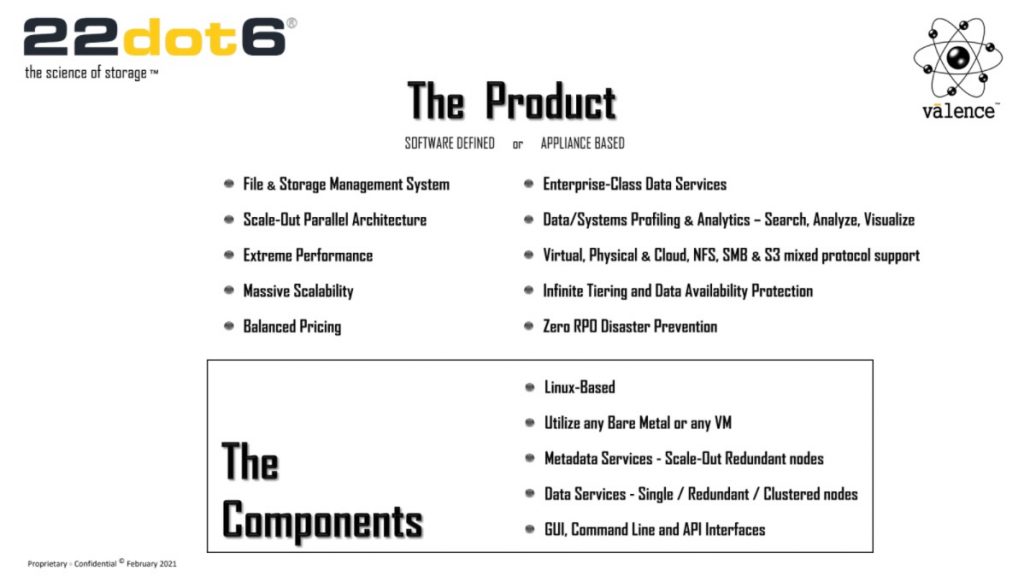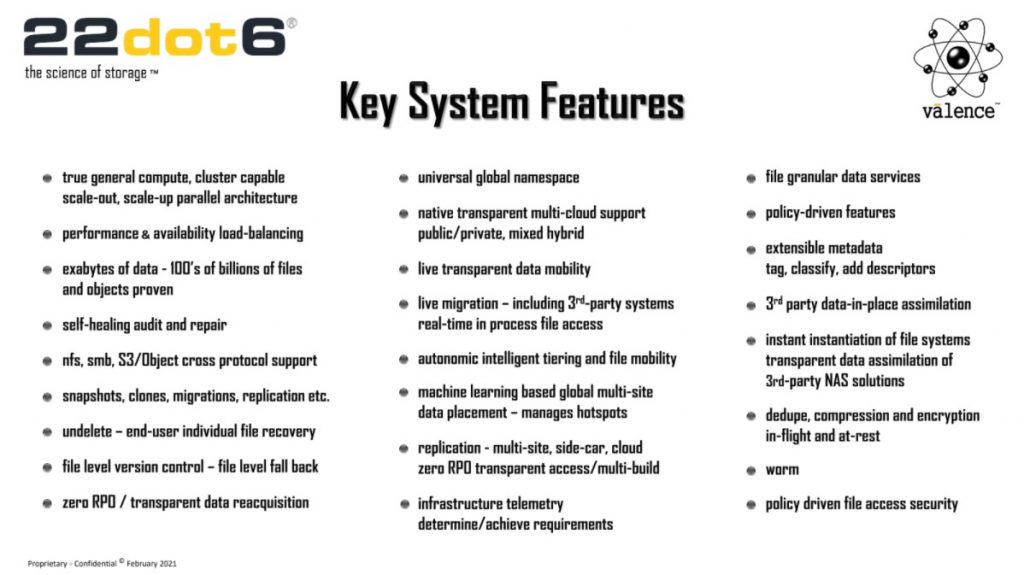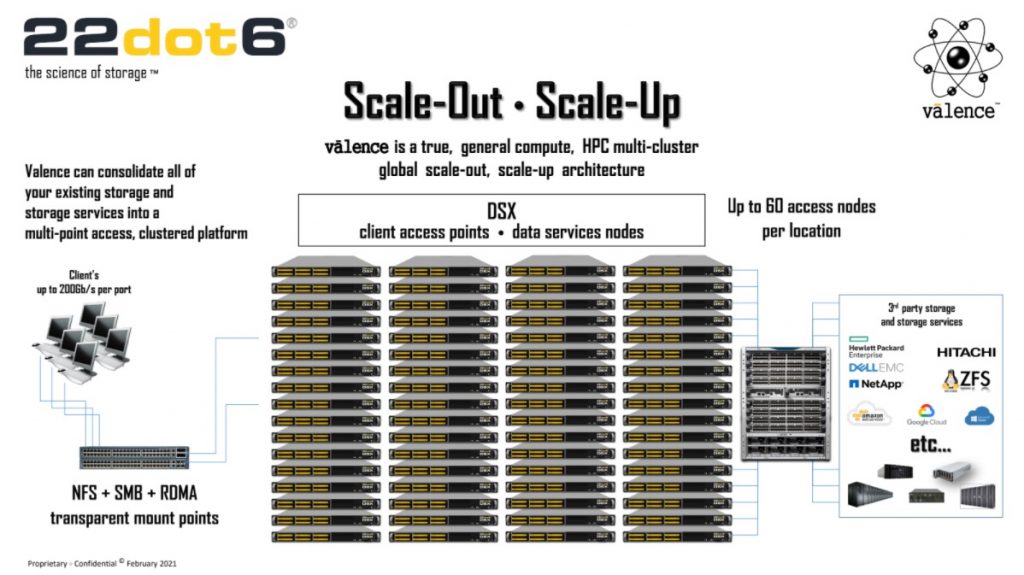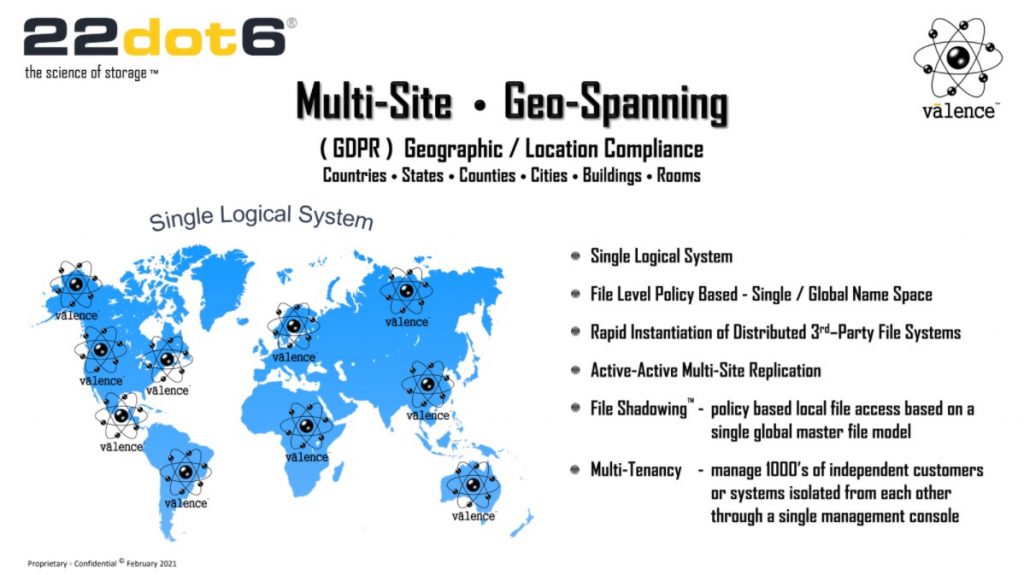Start-Up 22dot6 Out of Stealth Mode
With product named Valence, transcendent abstractive storage architecture for enterprises
This is a Press Release edited by StorageNewsletter.com on May 25, 2021 at 2:32 pmStorage start-up 22dot6, LLC launched today and introduced an enterprise storage architecture design for the commercial market – the industry’s first software-defined TASS (Transcendent Abstracted Storage System) architecture.
An evolutionary next step beyond storage virtualization and hardware abstraction, TASS enables enterprises to access, move, manage, and protect all data assets transparently, utilizing any available storage resource, regardless of the hardware manufacture, physical, virtual or cloud location, protocol, or platform. It unifies physical, virtual, on-premise, and cloud storage resources locally and globally, integrating users, applications and data services.
In a TASS architecture, NAS, object and cloud systems are unified eliminating the isolated islands and segregated silos of all traditional platforms, transcending past, present and future technologies while presenting the look, feel and simplicity of a single storage system. The solution enables users to manage totally disparate resources, regardless of location, as effectively as cloud storage.
Firm’s first product, its software Valence, creates a unified abstractive layer to transcend the limitations of conventional infrastructures, allow scale up/out, and provide the bridge between virtualization, hardware abstraction, data services and storage accessibility. With Valence, administrators can manage billions of files and exabytes of data within a true scale up/scale out architecture supporting a general compute HPC cluster of up to 60 data transport/access nodes per physical or virtual location and delivering data accessibility of 600-1,200 GB/s within a single global namespace. The software offers enterprise-level features plus industry-exclusive capabilities, including:
Ease of integration, migration, assimilation, transition
Move data from ground to cloud, cloud to cloud, cloud to ground with live, objective-based, infinite intelligent autonomic tiering. Integrate new and old or decommission legacy systems with live transparent data mobility. Valence supports off-line data management for archives like Amazon Glacier/tape providing location/device aware file level security implementing GDPR regulatory, and extended compliance capabilities.
High availability
The software inherently provides simultaneous file availability in a one-to-many node active/active configuration, guaranteeing 100% utilization of any available storage resource. All users can see and access all files in real time through all data transport nodes and every assigned network port simultaneously, regardless of location or resource. Valence eliminates hot-spots and the impact of hardware failures with machine learning, AI-based predictive analysis that manages data placement to meet performance and availability objectives.
High performance
As a scale-out/scale-up storage platform, TASS isolates and separates metadata management, data analytics/profiling and data services from the processes of providing IO/s and managing throughput. Valence assigns these inherently different tasks to dedicated CPUs and RAM, including SAS and PCIe board-level resources. It monitors all performance conditions in real time with predictive analysis and reporting to guarantee all user defined objectives – including read/write bandwidth, IO/s, and latency are maintained.
Data protection
Unlike most storage systems today that provide data services at a device or volume level, Valence provides the ability to configure all data protection services at an application, user and sub-file level. Integrated data cost analysis assigns the correct level of protection based on user definable metrics. It replaces file restore with immediate reacquisition and bypasses recovery through prevention. Utilizing undelete, fallback and master-copy direct access if a storage resource becomes unavailable, a file becomes corrupted, deleted or moved, Valence’s “Next In Line” file, device and location transcendent accessibility seamlessly connects the user or application to the next logical copy of the file regardless of location.
Active/Active Multi-Site
A TASS architecture transcends the concepts of a hot and cold site or resource. All sites can be considered as active site, sharing data in real time to any other site, and all sites can act as a primary site depending on the objective. Rather than disaster recovery or replication processes that use a hot/cold site model, Valence incorporates a “Master File” model with global file awareness to provide both transparent disaster prevention and multi-site, active file accessibility.
Metadata management, with integrated data and system profiling
It incorporates global indexing, search and analysis tools, providing administrators native capabilities to visualize, analyze and profile files, users, activities, performance and availability, based on virtually any query regardless of where the data resides. Metadata-level management enables tagging, classification, and triggers policies based on any file, application, user or system associated attribute.
Custom-defined objectives, management, and reporting
What, when, where and why. Objectives can be set for cost optimization, performance, resiliency, availability, device and/or location including scheduled permission defined accessibility, while Valence monitors and reports on virtually any aspect of the system.
Total multiprotocol support
Built to transcend the boundaries of NAS, object, cloud, S3, SMB, NFS, software-defined, physical, virtual and hybrid environments leveraging existing multi-manufacture components and off-the-shelf, commodity-based hardware.
Multi-tenant ready
Manage thousands of independent customers or internal departments isolated from each other through a unified, multi-location management console.
“Once every decade or so, breakthroughs in computing trigger an innovative leap in the way we manage, store, protect and access our data. A software defined T.A.S.S. architecture is not theoretical and represents that type of leap. Valence transcends the boundaries of your isolated islands and segregated silos of traditional storage models and gives us the ability to place and access files anywhere, anytime on anything,” said founder and CEO Diamond Lauffin.
22dot6, the name is derived from the density of osmium (22.5872g/cm3) 22.6, a transitional metal considered the densest natural element in the world. Its unknown existence was predicted by Russian scientist Dmitri Mendeleyev who created the periodic table of elements. Mendeleyev without seeing knew osmium must exist based on presumed characteristics. Like Mendeleyev, over the last 25 years the founder of 22dot6 is credited with understanding, identifying and providing prior, unknown or applied contributions to the periodic table of storage.
vā•lence – vā′ləns: More than just a name.
1: a relative capacity to a unit, 2: the combining capacity of an atom or group of atoms as determined by the number of electrons it can lose, add, or share when it reacts with other atoms or groups, 3: the capacity of one to react with or affect another in some special way.
Comments
The first remark is related to the period when the company is publicly launched. In fact the project started in 2015 and the investment is still a mystery. Even if the technology is being developed for a few years, unveiling such project during a pandemic is courageous. Based on their culture, some population around the world claim that such worldwide challenge offer some opportunities, others seem to be more conservative and finally reluctant to ignite such effort. Clearly the 22dot6 team estimates that the story is enough compelling to launch the company and the product. Brilliant.
The company is founded by CEO Diamond Lauffin, co-founder StorByte. He also had several sales executives positions at Nexsan, FileTek or Qualstar. It's always strange to have a sales profile creating, speaking and promoting technologies trying to convince real technical people... His LinkedIn profile is surprisingly very limited with no date at all. We even recognized some StorByte bezels in the 22dot6 presentation.
The industry via some vendors always try to create product category and this time, beyond NAS, CAS, etc. 22dot6 introduces TASS. We also need to mention of course SAN as TASS refers to an architecture and is the acronym of Transcendent Abstrated Storage System. Not related to Time Addressable Storage, the firm claims to be the first software-defined TASS. Of course it is as 22dot6 promotes it. But there is a danger, trying to introduced a new category is always a challenge as the actor doing so is of course alone and can't be compared with others. This could impact adoption as users, even early adopters, wish to compare different offering. Also having several products in a category confirms a market trend. We all have examples in mind with companies trying to introduce their own category, being alone for too long with limited adoption and finally reposition and classify their product into a existing product segment. Among others, we remember Active Circle, an innovative distributed file storage solution launched in 2002 as cellular data storage that got repositioned as clustered file storage a few quarters later.

But beyond an architecture, the start-up announced a product named Valence as everything is linked to the chemistry world. The product is finally an intelligent aggregator, unificator, storage router with a rich set of data services, sometimes called a gateway coupling diverse back-end storage entities. At that level, it is able to unify NAS, on-premises and cloud object storage and even tape, exposing NFS, SMB and S3 on the front-end i.e at the application clients levels. Surfing on a key characteristic introduced several years ago, the product is able to offer access the same content via NAS and S3 access methods. This aggregation capabilities immediately give to users investment protection and storage asset preservation without the need to replace and refresh existing storage devices, servers, units.

The product operates in the data path or in-band and groups tons of data services as it is described in the press release above. The product seems to be pretty scalable with 60 DSX or data access nodes with 600 to 1,200GB/s per namespace. An AI-based predictive analysis feature is added with ML to optimize data access and placement.

It reminds what we saw many years ago with NFM/NFV (Network File Management/Network File Virtualization) players like Acopia, AutoVirt, Storigen, NeoPath, Attune or NuView limited to file environments. At the time object storage was not so developed or existent and S3 was absent as we know it today, a de-facto standard.

Valence also participates to a real trend with multi-geo capabilities as several vendor prepare some products to deliver local access to geo distributed, sometimes dispersed, data over distincts storage entities and sites.
We understand that the data management engine embedded in the DSX/VSR nodes works at the file level but doesn't offer back-end parallelism across NAS and or S3 entities with striping or chunking. In other words, a file belongs to one storage entity and is protected with snapshot and replication. It means that we don't have a file split across multiple back-end NAS servers giving to Valence some parallelism capabilities to boost I/O like pNFS can do. We don't see either some erasure coding techniques across back-end storage even across local ones not necessarily dispersed.
The product is already deployed to a few beta sites and user experience seems to be positive as the product delivers pretty comprehensive data services that simplify day to day life for system and storage admins.
In term of competition, the product could be compared to several categories such global file services with Nasuni, CTera and Panzura, secondary storage player Cohesity for sure even with lake of support of tape, or even QStar, Point.de, Versity among others especially on the aggregation and access protocols sides and for some uses cases. But direct competition with the most comprehensive comparable features set remain StrongBox with StrongLink, Hammerspace or DataCore vFilO (Hammerspace oem).













 Subscribe to our free daily newsletter
Subscribe to our free daily newsletter

